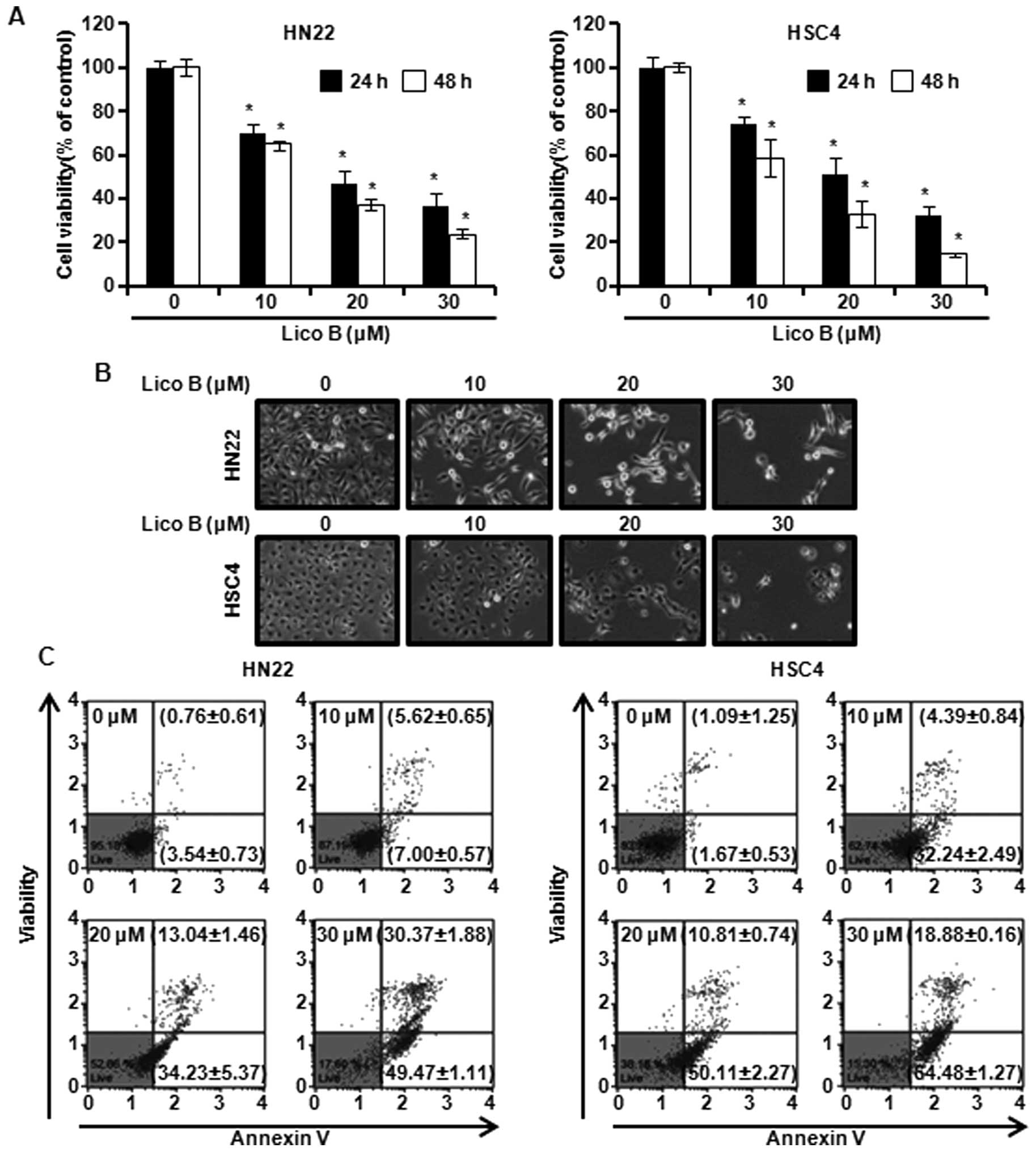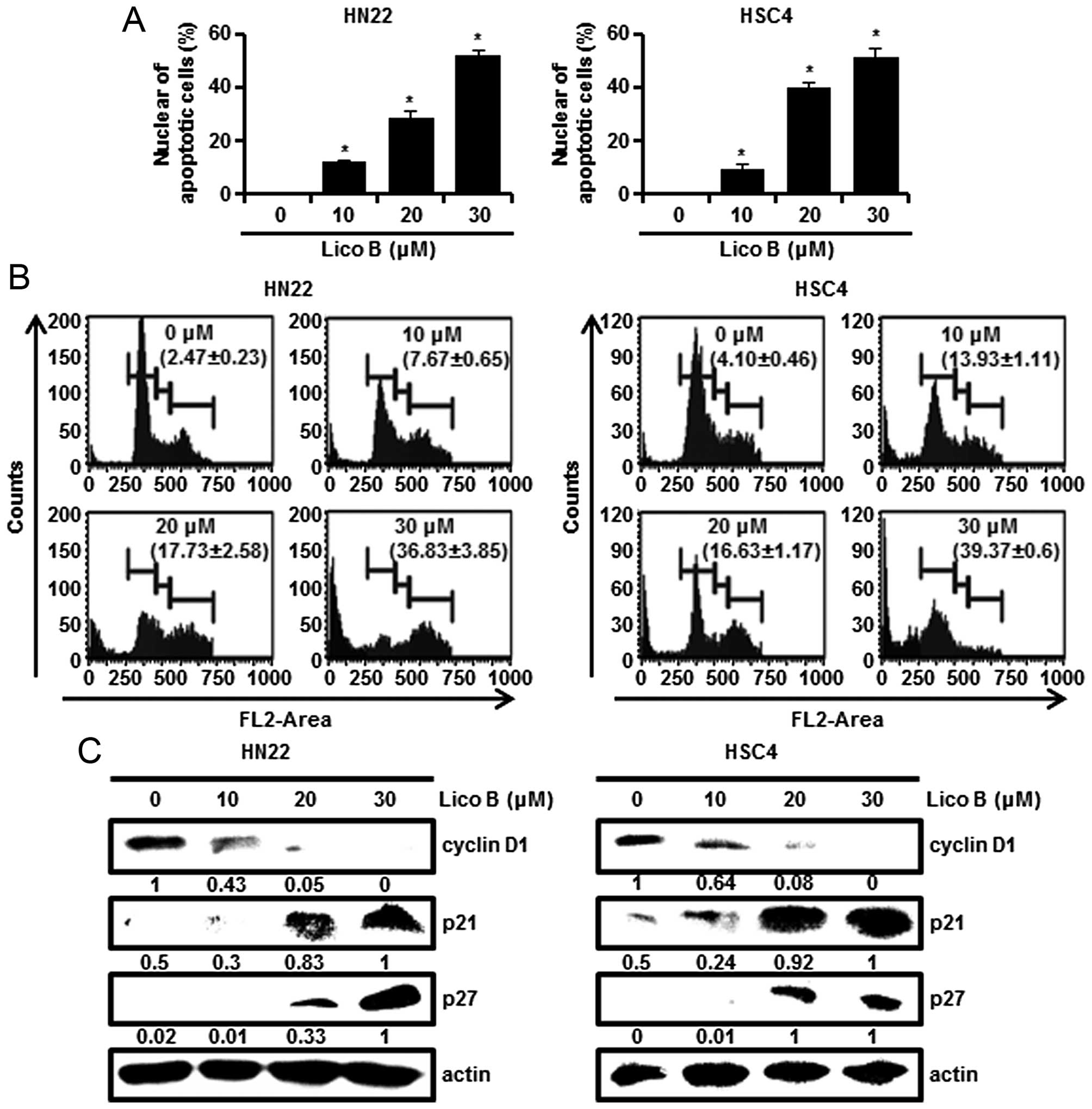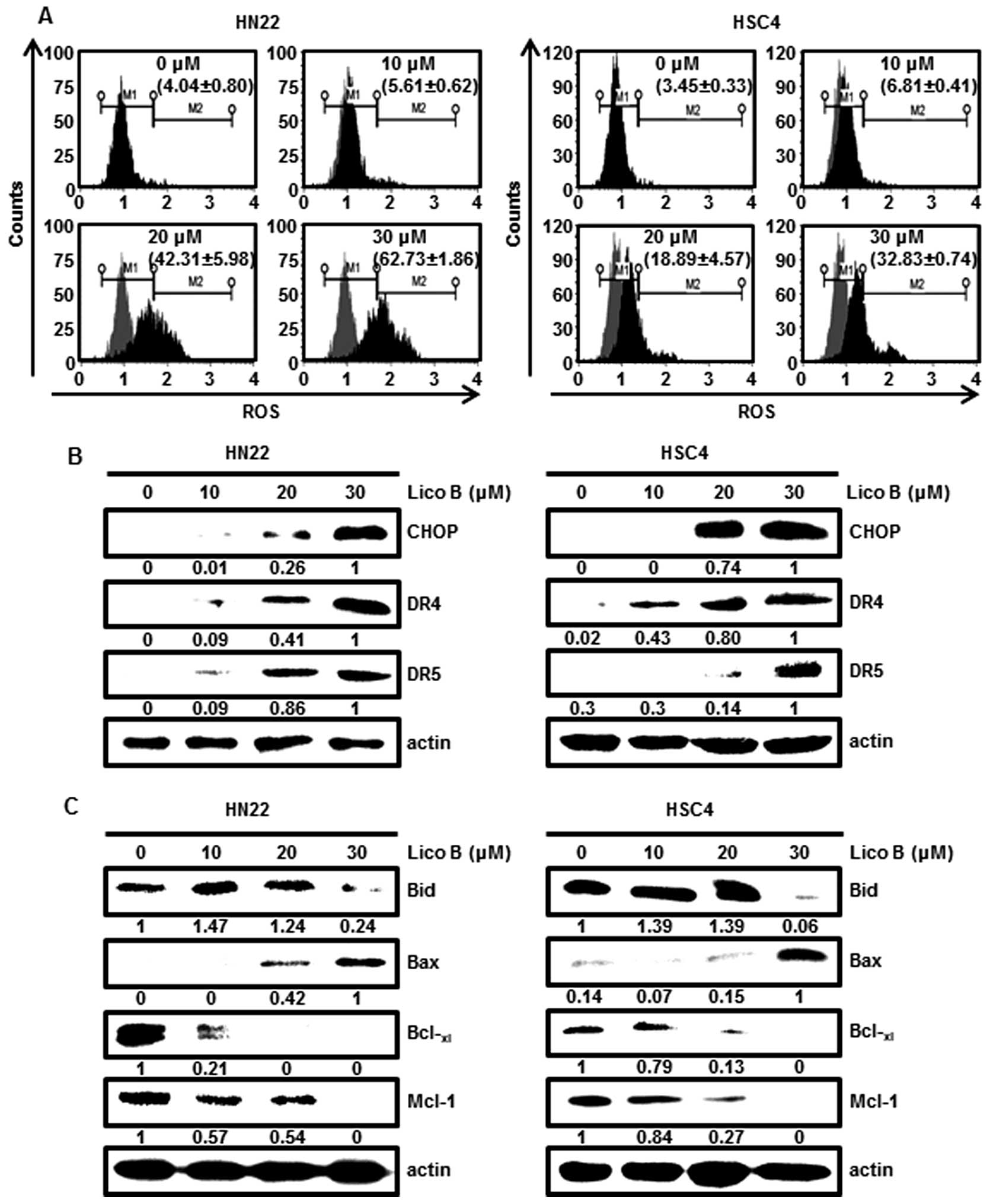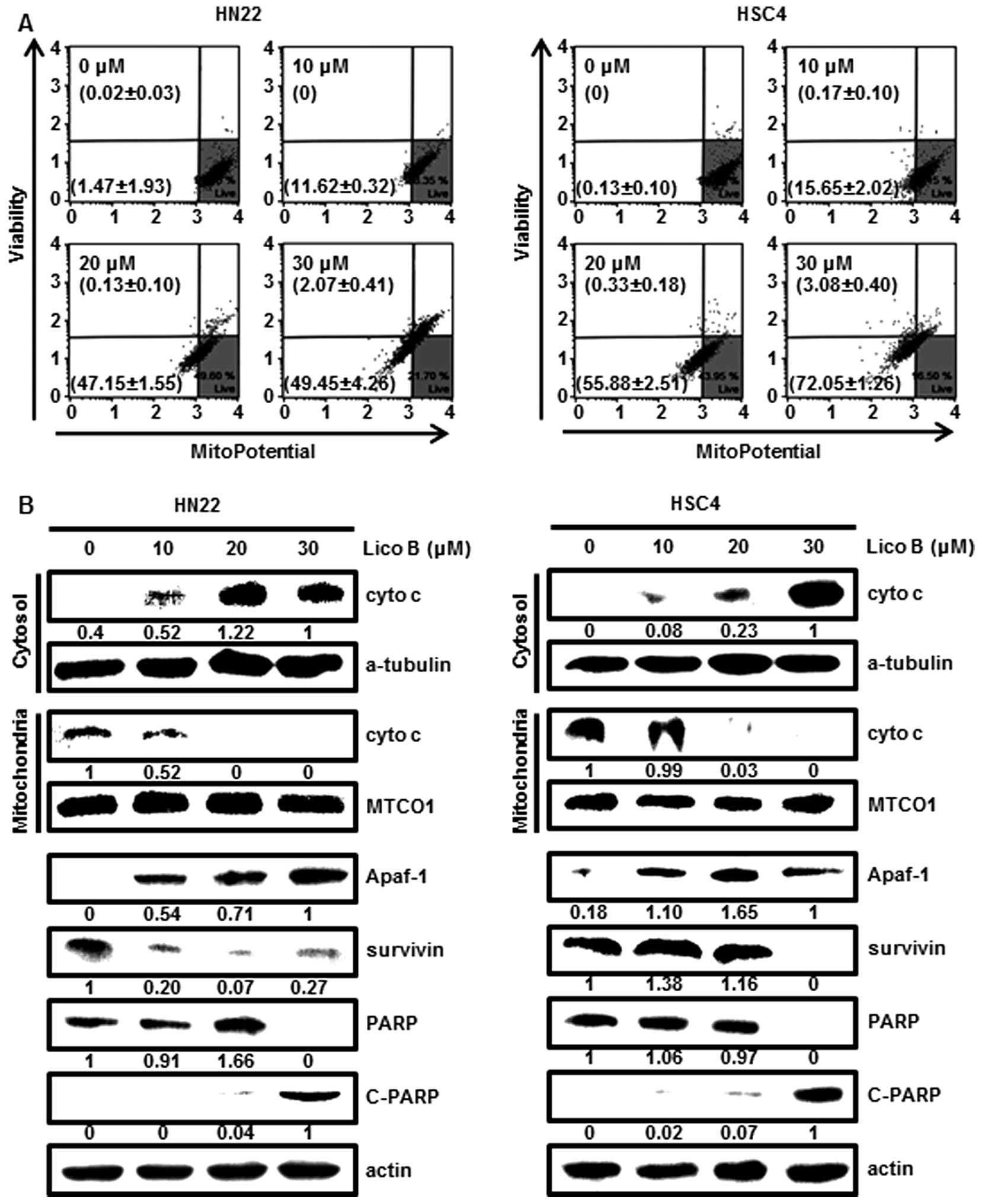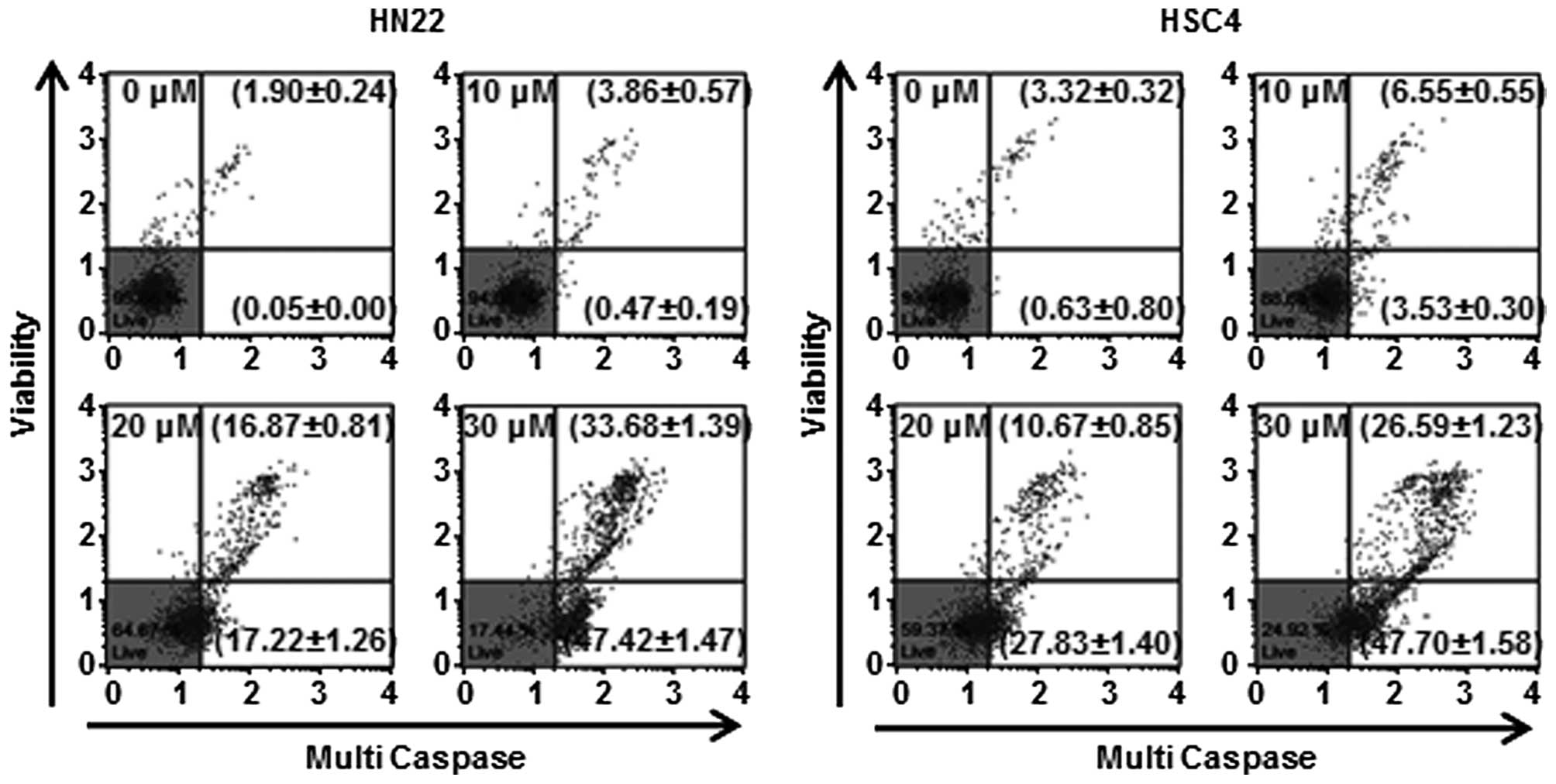|
1
|
Zeng G, Shen H, Yang Y, Cai X and Xun W:
Licochalcone A as a potent antitumor agent suppresses growth of
human oral cancer SCC-25 cells in vitro via caspase-3 dependent
pathways. Tumour Biol. 35:6549–6555. 2014. View Article : Google Scholar : PubMed/NCBI
|
|
2
|
Neville BW and Day TA: Oral cancer and
precancerous lesions. CA Cancer J Clin. 52:195–215. 2002.
View Article : Google Scholar : PubMed/NCBI
|
|
3
|
Ni ZY, Lin FO, Liu DF and Xiao J:
Decreased microRNA-143 expression and its tumor suppressive
function in human oral squamous cell carcinoma. Genet Mol Res.
14:6943–6952. 2015. View Article : Google Scholar : PubMed/NCBI
|
|
4
|
Shin JA, Jung JY, Ryu MH, Safe S and Cho
SD: Mithramycin A inhibits myeloid cell leukemia-1 to induce
apoptosis in oral squamous cell carcinomas and tumor xenograft
through activation of Bax and oligomerization. Mol Pharmacol.
83:33–41. 2013. View Article : Google Scholar
|
|
5
|
Shin JA, Kim JS, Kwon KH, Nam JS, Jung JY,
Cho NP and Cho SD: Apoptotic effect of hot water extract of
Sanguisorba officinalis L. in human oral cancer cells. Oncol Lett.
4:489–494. 2012.
|
|
6
|
Yuan X, Li T, Xiao E, Zhao H, Li Y, Fu S,
Gan L and Wang Z, Zheng Q and Wang Z: Licochalcone B inhibits
growth of bladder cancer cells by arresting cell cycle progression
and inducing apoptosis. Food Chem Toxicol. 65:242–251. 2014.
View Article : Google Scholar : PubMed/NCBI
|
|
7
|
Fu Y, Chen J, Li YJ, Zheng YF and Li P:
Antioxidant and anti-inflammatory activities of six flavonoids
separated from licorice. Food Chem. 141:1063–1071. 2013. View Article : Google Scholar : PubMed/NCBI
|
|
8
|
Furusawa J, Funakoshi-Tago M, Mashino T,
Tago K, Inoue H, Sonoda Y and Kasahara T: Glycyrrhiza
inflata-derived chalcones, Licochalcone A, Licochalcone B and
Licochalcone D, inhibit phosphorylation of NF-kappaB p65 in LPS
signaling pathway. Int Immunopharmacol. 9:499–507. 2009. View Article : Google Scholar : PubMed/NCBI
|
|
9
|
Park SY, Kim EJ, Choi HJ, Seon MR, Lim SS,
Kang YH, Choi MS, Lee KW and Yoon Park JH: Anti-carcinogenic
effects of non-polar components containing licochalcone A in
roasted licorice root. Nutr Res Pract. 8:257–266. 2014. View Article : Google Scholar : PubMed/NCBI
|
|
10
|
Zhao H, Yuan X, Jiang J, Wang P, Sun X,
Wang D and Zheng Q: Antimetastatic effects of licochalcone B on
human bladder carcinoma T24 by inhibition of matrix
metalloproteinases-9 and NF-κB activity. Basic Clin Pharmacol
Toxicol. 115:527–533. 2014. View Article : Google Scholar : PubMed/NCBI
|
|
11
|
Elmore S: Apoptosis: A review of
programmed cell death. Toxicol Pathol. 35:495–516. 2007. View Article : Google Scholar : PubMed/NCBI
|
|
12
|
Lee MS, Cherla RP, Lentz EK, Leyva-Illades
D and Tesh VL: Signaling through C/EBP homologous protein and death
receptor 5 and calpain activation differentially regulate THP-1
cell maturation-dependent apoptosis induced by Shiga toxin type 1.
Infect Immun. 78:3378–3391. 2010. View Article : Google Scholar : PubMed/NCBI
|
|
13
|
Zhu H, Liu XW, Ding WJ, Xu DQ, Zhao YC, Lu
W, He QJ and Yang B: Up-regulation of death receptor 4 and 5 by
celastrol enhances the anti-cancer activity of TRAIL/Apo-2L. Cancer
Lett. 297:155–164. 2010. View Article : Google Scholar : PubMed/NCBI
|
|
14
|
Huang TT, Liu FG, Wei CF, Lu CC, Chen CC,
Lin HC, Ojcius DM and Lai HC: Activation of multiple apoptotic
pathways in human nasopharyngeal carcinoma cells by the prenylated
isoflavone, osajin. PLoS One. 6:e183082011. View Article : Google Scholar : PubMed/NCBI
|
|
15
|
Farooqi AA, Li KT, Fayyaz S, Chang YT,
Ismail M, Liaw CC, Yuan SS, Tang JY and Chang HW: Anticancer drugs
for the modulation of endoplasmic reticulum stress and oxidative
stress. Tumour Biol. 36:5743–5752. 2015. View Article : Google Scholar : PubMed/NCBI
|
|
16
|
Xu L, Su L and Liu X: PKCδ regulates death
receptor 5 expression induced by PS-341 through ATF4-ATF3/CHOP axis
in human lung cancer cells. Mol Cancer Ther. 11:2174–2182. 2012.
View Article : Google Scholar : PubMed/NCBI
|
|
17
|
Prasad S, Yadav VR, Ravindran J and
Aggarwal BB: ROS and CHOP are critical for dibenzylideneacetone to
sensitize tumor cells to TRAIL through induction of death receptors
and down-regulation of cell survival proteins. Cancer Res.
71:538–549. 2011. View Article : Google Scholar :
|
|
18
|
Wang Z, Liu Z, Cao Y, Paudel S, Yoon G and
Cheon SH: Short and efficient synthesis of licochalcone B and D
through acid-mediated Claisen-Schmidt condensation. Bull Korean
Chem Soc. 34:3906–3908. 2013. View Article : Google Scholar
|
|
19
|
Cho JJ, Chae JI, Yoon G, Kim KH, Cho JH,
Cho SS, Cho YS and Shim JH: Licochalcone A, a natural chalconoid
isolated from Glycyrrhiza inflata root, induces apoptosis via Sp1
and Sp1 regulatory proteins in oral squamous cell carcinoma. Int J
Oncol. 45:667–674. 2014.PubMed/NCBI
|
|
20
|
Janes SM, Ofstad TA, Campbell DH, Eddaoudi
A, Warnes G, Davies D and Watt FM: PI3-kinase-dependent activation
of apoptotic machinery occurs on commitment of epidermal
keratinocytes to terminal differentiation. Cell Res. 19:328–339.
2009. View Article : Google Scholar :
|
|
21
|
Fu HY, Okada K, Liao Y, Tsukamoto O,
Isomura T, Asai M, Sawada T, Okuda K, Asano Y, Sanada S, et al:
Ablation of C/EBP homologous protein attenuates endoplasmic
reticulum-mediated apoptosis and cardiac dysfunction induced by
pressure overload. Circulation. 122:361–369. 2010. View Article : Google Scholar : PubMed/NCBI
|
|
22
|
Shin DY, Park YS, Yang K, Kim GY, Kim WJ,
Han MH, Kang HS and Choi YH: Decitabine, a DNA methyltransferase
inhibitor, induces apoptosis in human leukemia cells through
intracellular reactive oxygen species generation. Int J Oncol.
41:910–918. 2012.PubMed/NCBI
|
|
23
|
Habibie YS, Yokoyama S, Abdelhamed S,
Awale S, Sakurai H, Hayakawa Y and Saiki I: Survivin suppression
through STAT3/β-catenin is essential for resveratrol-induced
melanoma apoptosis. Int J Oncol. 45:895–901. 2014.PubMed/NCBI
|
|
24
|
Kim YS, Kim EA, Park KG, Lee SJ, Kim MS,
Sohn HY and Lee TJ: Dioscin sensitizes cells to TRAIL-induced
apoptosis through downregulation of c-FLIP and Bcl-2. Oncol Rep.
28:1910–1916. 2012.PubMed/NCBI
|
|
25
|
Law CK, Kwok HH, Poon PY, Lau CC, Jiang
ZH, Tai WC, Hsiao WW, Mak NK, Yue PY and Wong RN: Ginsenoside
compound K induces apoptosis in nasopharyngeal carcinoma cells via
activation of apoptosis-inducing factor. Chin Med. 9:112014.
View Article : Google Scholar : PubMed/NCBI
|
|
26
|
Hearps AC, Burrows J, Connor CE, Woods GM,
Lowenthal RM and Ragg SJ: Mitochondrial cytochrome c release
precedes transmembrane depolarisation and caspase-3 activation
during ceramide-induced apoptosis of Jurkat T cells. Apoptosis.
7:387–394. 2002. View Article : Google Scholar : PubMed/NCBI
|
|
27
|
Choi ES, Cho SD, Jeon JG and Cho NP: The
apoptotic effect of the hexane extract of Rheum undulatum L. in
oral cancer cells through the down-regulation of specificity
protein 1 and survivin. Lab Anim Res. 27:19–24. 2011. View Article : Google Scholar : PubMed/NCBI
|
|
28
|
Mahapatra DK, Bharti SK and Asati V:
Chalcone scaffolds as anti-infective agents: Structural and
molecular target perspectives. Eur J Med Chem. 101:496–524. 2015.
View Article : Google Scholar : PubMed/NCBI
|
|
29
|
Yalcin A, Clem BF, Imbert-Fernandez Y,
Ozcan SC, Peker S, O'Neal J, Klarer AC, Clem AL, Telang S and
Chesney J: 6-Phosphofructo-2-kinase (PFKFB3) promotes cell cycle
progression and suppresses apoptosis via Cdk1-mediated
phos-phorylation of p27. Cell Death Dis. 5:e13372014. View Article : Google Scholar
|
|
30
|
Alao JP: The regulation of cyclin D1
degradation: Roles in cancer development and the potential for
therapeutic invention. Mol Cancer. 6:242007. View Article : Google Scholar : PubMed/NCBI
|
|
31
|
Han MH, Lee WS, Jung JH, Jeong JH, Park C,
Kim HJ, Kim G, Jung JM, Kwon TK, Kim GY, et al: Polyphenols
isolated from Allium cepa L. induces apoptosis by suppressing IAP-1
through inhibiting PI3K/Akt signaling pathways in human leukemic
cells. Food Chem Toxicol. 62:382–389. 2013. View Article : Google Scholar : PubMed/NCBI
|
|
32
|
Federico A, Cardaioli E, Da Pozzo P,
Formichi P, Gallus GN and Radi E: Mitochondria, oxidative stress
and neurodegeneration. J Neurol Sci. 322:254–262. 2012. View Article : Google Scholar : PubMed/NCBI
|
|
33
|
Kim IY, Kang YJ, Yoon MJ, Kim EH, Kim SU,
Kwon TK, Kim IA and Choi KS: Amiodarone sensitizes human glioma
cells but not astrocytes to TRAIL-induced apoptosis via
CHOP-mediated DR5 upregulation. Neuro Oncol. 13:267–279. 2011.
View Article : Google Scholar : PubMed/NCBI
|
|
34
|
Kim CD, Cha JD, Li S and Cha IH: The
mechanism of acacetin-induced apoptosis on oral squamous cell
carcinoma. Arch Oral Biol. 60:1283–1298. 2015. View Article : Google Scholar : PubMed/NCBI
|
|
35
|
Giam M, Huang DC and Bouillet P: BH3-only
proteins and their roles in programmed cell death. Oncogene.
27(Suppl 1): S128–S136. 2008. View Article : Google Scholar
|
|
36
|
Ola MS, Nawaz M and Ahsan H: Role of Bcl-2
family proteins and caspases in the regulation of apoptosis. Mol
Cell Biochem. 351:41–58. 2011. View Article : Google Scholar : PubMed/NCBI
|
|
37
|
Sha SH, Chen FQ and Schacht J: Activation
of cell death pathways in the inner ear of the aging CBA/J mouse.
Hear Res. 254:92–99. 2009. View Article : Google Scholar : PubMed/NCBI
|
|
38
|
Hunter AM, LaCasse EC and Korneluk RG: The
inhibitors of apoptosis (IAPs) as cancer targets. Apoptosis.
12:1543–1568. 2007. View Article : Google Scholar : PubMed/NCBI
|















